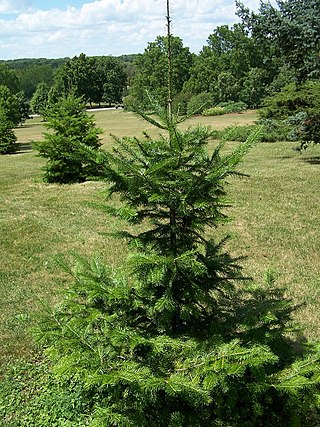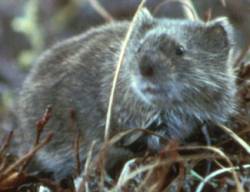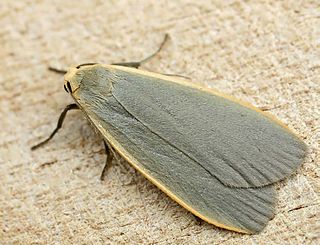
The Arvicolinae are a subfamily of rodents that includes the voles, lemmings, and muskrats. They are most closely related to the other subfamilies in the Cricetidae. Some authorities place the subfamily Arvicolinae in the family Muridae along with all other members of the superfamily Muroidea. Some refer to the subfamily as the Microtinae or rank the taxon as a full family, the Arvicolidae.

Microtus is a genus of voles found in North America, Europe and northern Asia. The genus name refers to the small ears of these animals. About 62 species are placed in the genus. They are stout rodents with short ears, legs and tails. They eat green vegetation such as grasses and sedges in summer, and grains, seeds, root and bark at other times. The genus is also called "meadow voles".

The tundra vole or root vole is a medium-sized vole found in Northern and Central Europe, Asia, and northwestern North America, including Alaska and northwestern Canada. In the western part of the Netherlands, the tundra vole is a relict from the ice age and has developed into the subspecies Alexandromys oeconomus arenicola.

Nipponosaurus is a lambeosaurine hadrosaur from sediments of the Yezo Group, in Sinegorsk on the island of Sakhalin, which was part of Japan at the time of the species' classification. The type and only species is N. sachalinensis, known only from a single juvenile specimen discovered in 1934 and named in 1936, by Takumi Nagao, with further material of the same individual found in 1937. Since then, the taxon has been largely ignored, and its validity has been doubted, with synonymy with other Asian hadrosaurs or status as a nomen dubium being suggested. Redescriptions from 2004 and 2017, however, have supported recognition as a distinct species. Dating the only specimen has been difficult, but based on associated mollusc taxa, the species likely lived sometime in the upper Santonian or lower Campanian, around 80 million years ago.

The reed vole is a species of vole. It is found in northern and central Eurasia, including northern China and the Korean Peninsula. This species is somewhat larger and longer-tailed than most other voles.

Reynoutria sachalinensis is a species of Fallopia native to northeastern Asia in northern Japan and the far east of Russia.

The lacustrine vole is a species of rodent in the family Cricetidae. It is found in China and Mongolia.
Maximowicz's vole is a species of rodent in the family Cricetidae. It is found in northeastern China, Mongolia, and eastern Russia.
Middendorff's vole is a species of rodent in the family Cricetidae. It is found only in Russia, most commonly north Siberia.
The Mongolian vole is a species of rodent in the family Cricetidae. It is found in China, Mongolia, and Russia.
The Muya Valley vole or Muisk vole is a species of rodent in the family Cricetidae. It is found only in Russia.

The Taiwan vole is a species of rodent in the family Cricetidae, It is an endemic species of Taiwan. This species is herbivorous with a preference for the Yushan cane.

Abies nephrolepis, commonly known as Khingan fir, is a species of fir native to northeastern China, North Korea, South Korea, and southeastern Russia.

Abies sachalinensis, the Sakhalin fir, is a species of conifer in the family Pinaceae. It is found in Sakhalin island and southern Kurils (Russia), and also in northern Hokkaido (Japan). The first discovery by a European was by Carl Friedrich Schmidt (1832-1908), the Baltic German botanist, on the Russian island of Sakhalin in 1866, but he did not introduce it to Europe. The plant was re-discovered by the English plant-collector, Charles Maries in 1877 near Aomori on the main Japanese island of Honshū, who initially thought it to be a variety of Abies veitchii. Abies nephrolepis is known to be the closest relative, which exists on the mainland just west of the range of Sakhalin fir.

Alexandromys is a genus of voles in the subfamily Arvicolinae, formerly a subgenus of the genus Microtus. Species in this subgenus are:

Collita griseola, the dingy footman, is a moth of the family Erebidae. The species was first described by Jacob Hübner in 1803. It is found in Europe and North and South-East Asia.

Lopinga deidamia is a species of butterfly in the family Nymphalidae. It is found from the Urals to southern Siberia, China, Mongolia, Korea and Japan.

The South Sakhalin-Kurile mixed forests ecoregion is split between the southwest region of Sakhalin Island, and the southern three islands of the Kurile Islands chain in the Russian Far East. The ecoregion is in the Palearctic realm, with a Humid Continental climate. It covers 12,432 km2 (4,800 sq mi).

Reynoutria is a genus of flowering plants in the family Polygonaceae. The genus is native to eastern China, Eastern Asia and the Russian Far East, although species have been introduced to Europe and North America. Members of the genus, including R. japonica and its hybrid with R. sachalinensis, are highly invasive plants.















